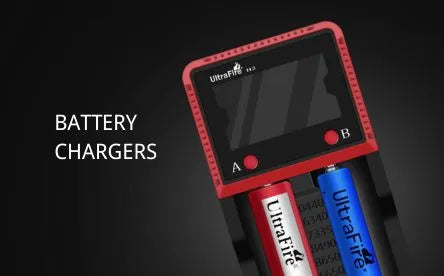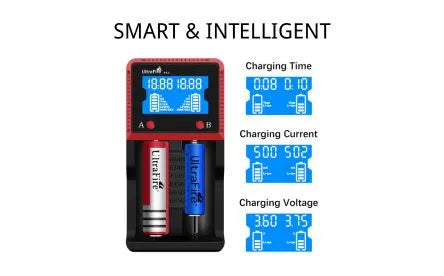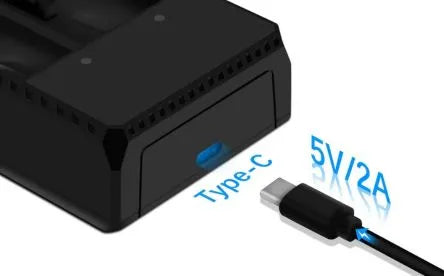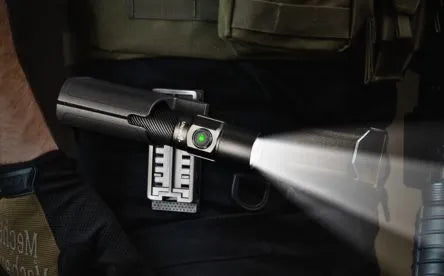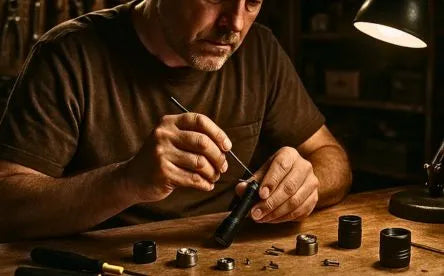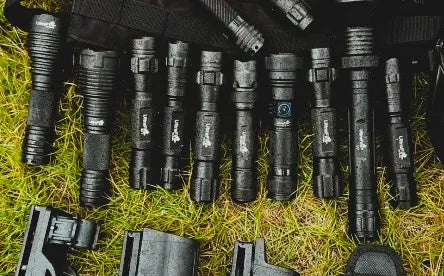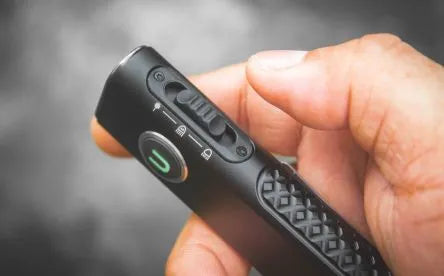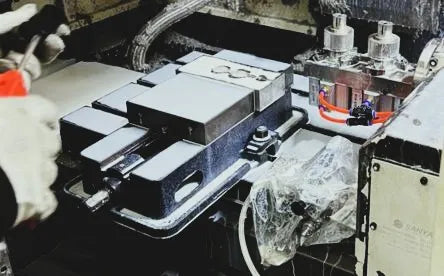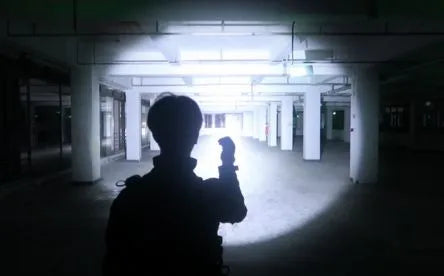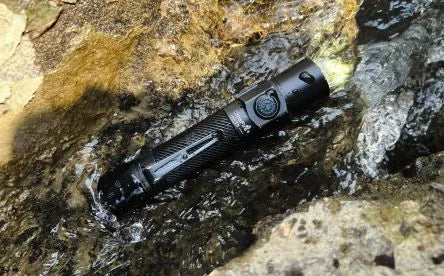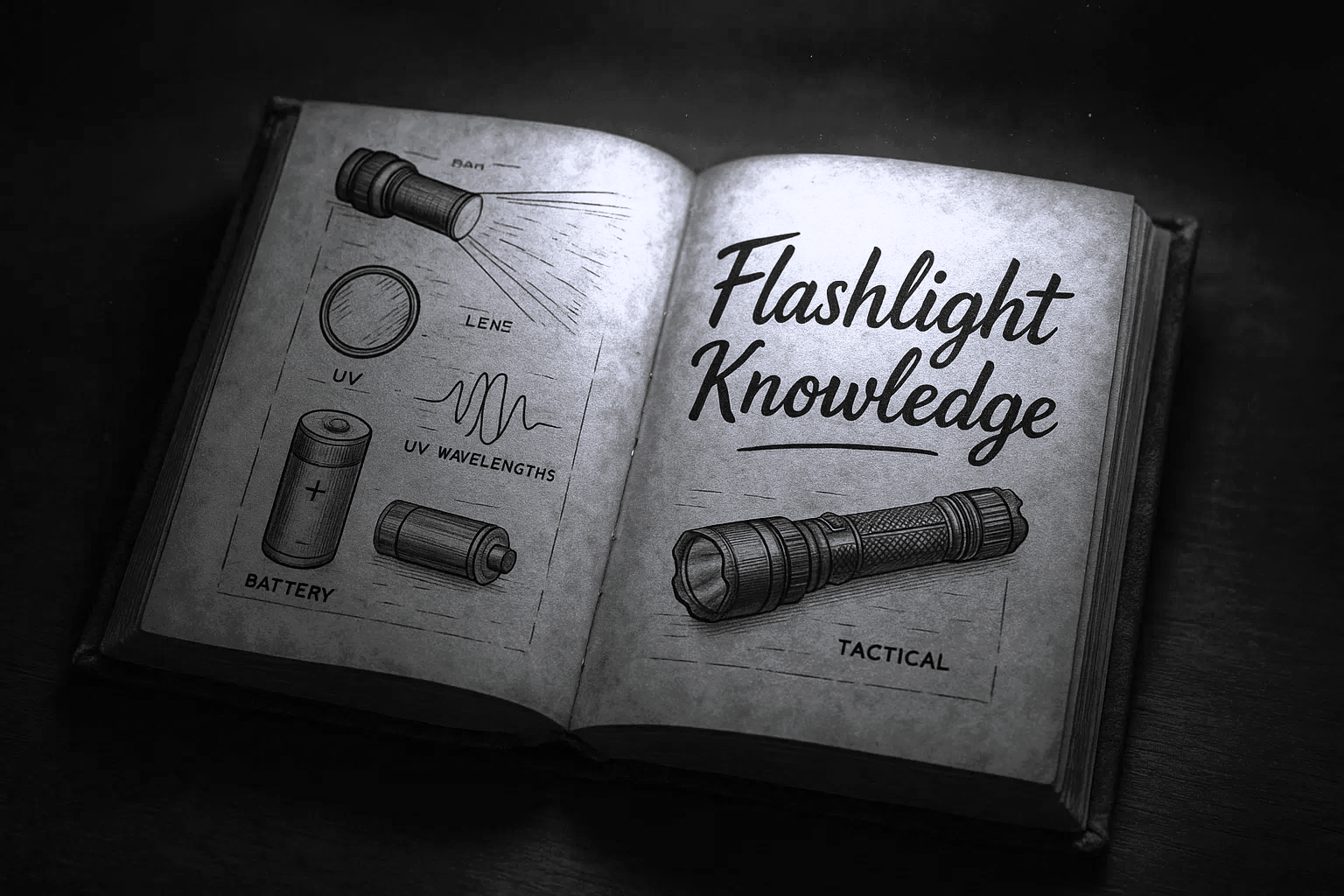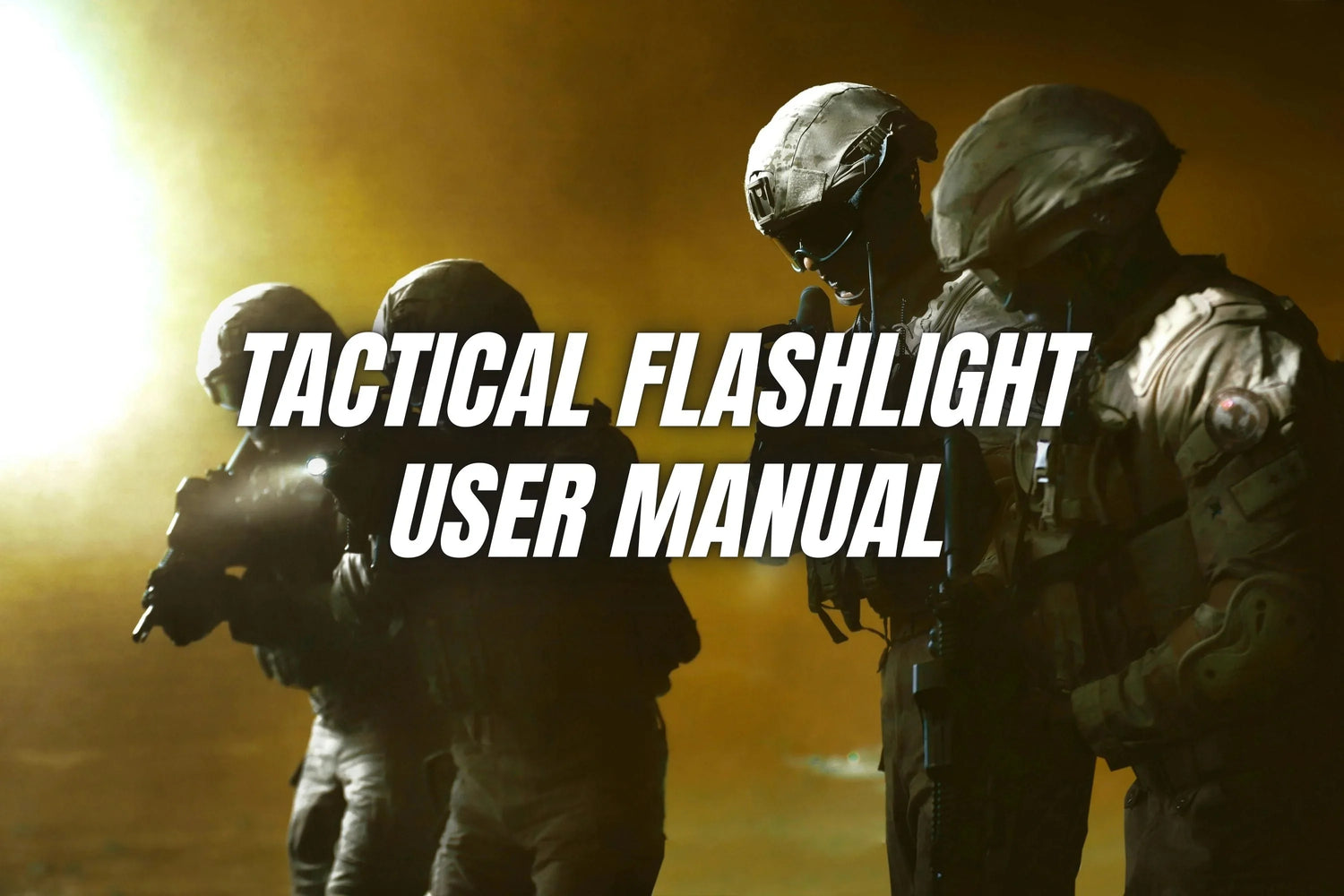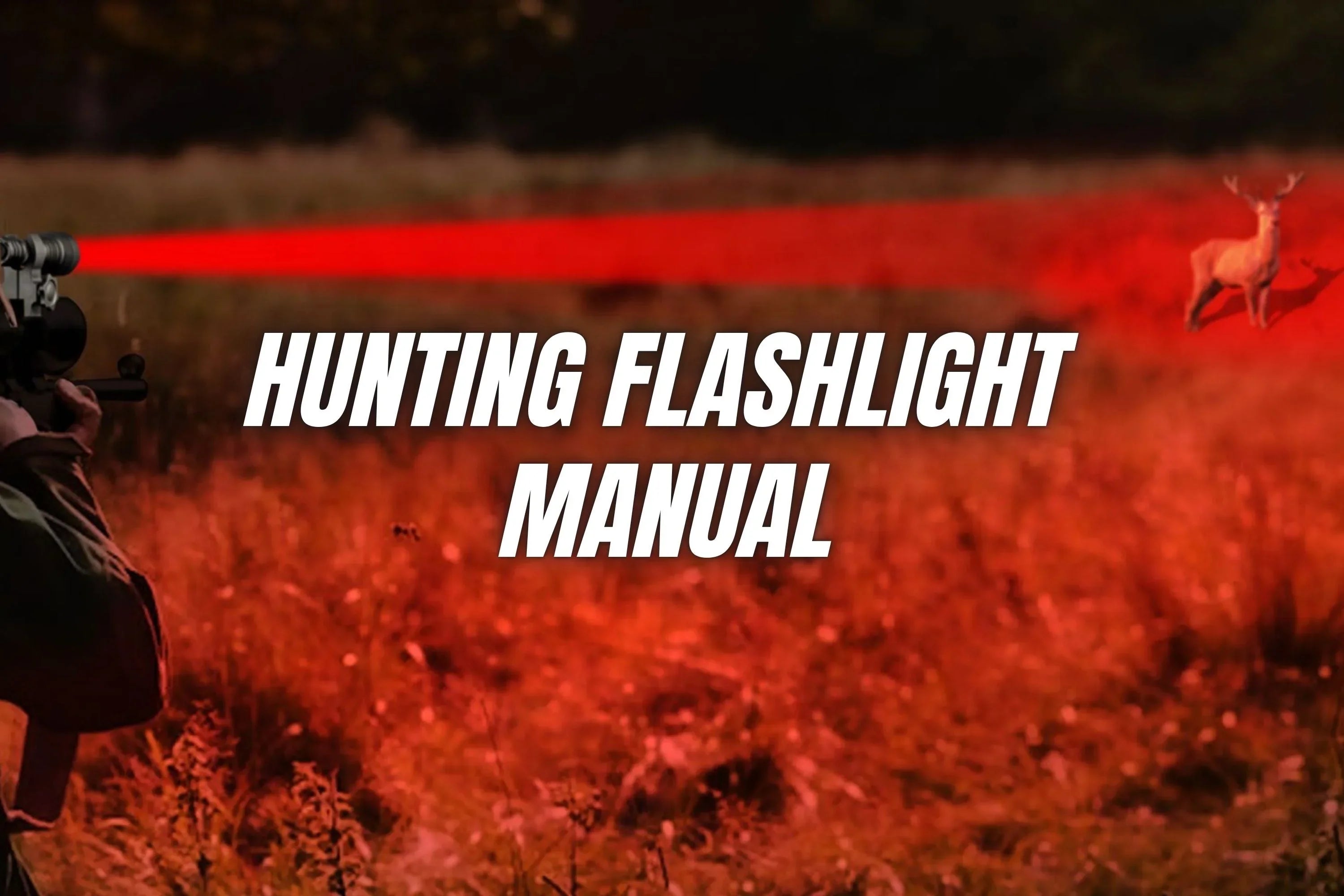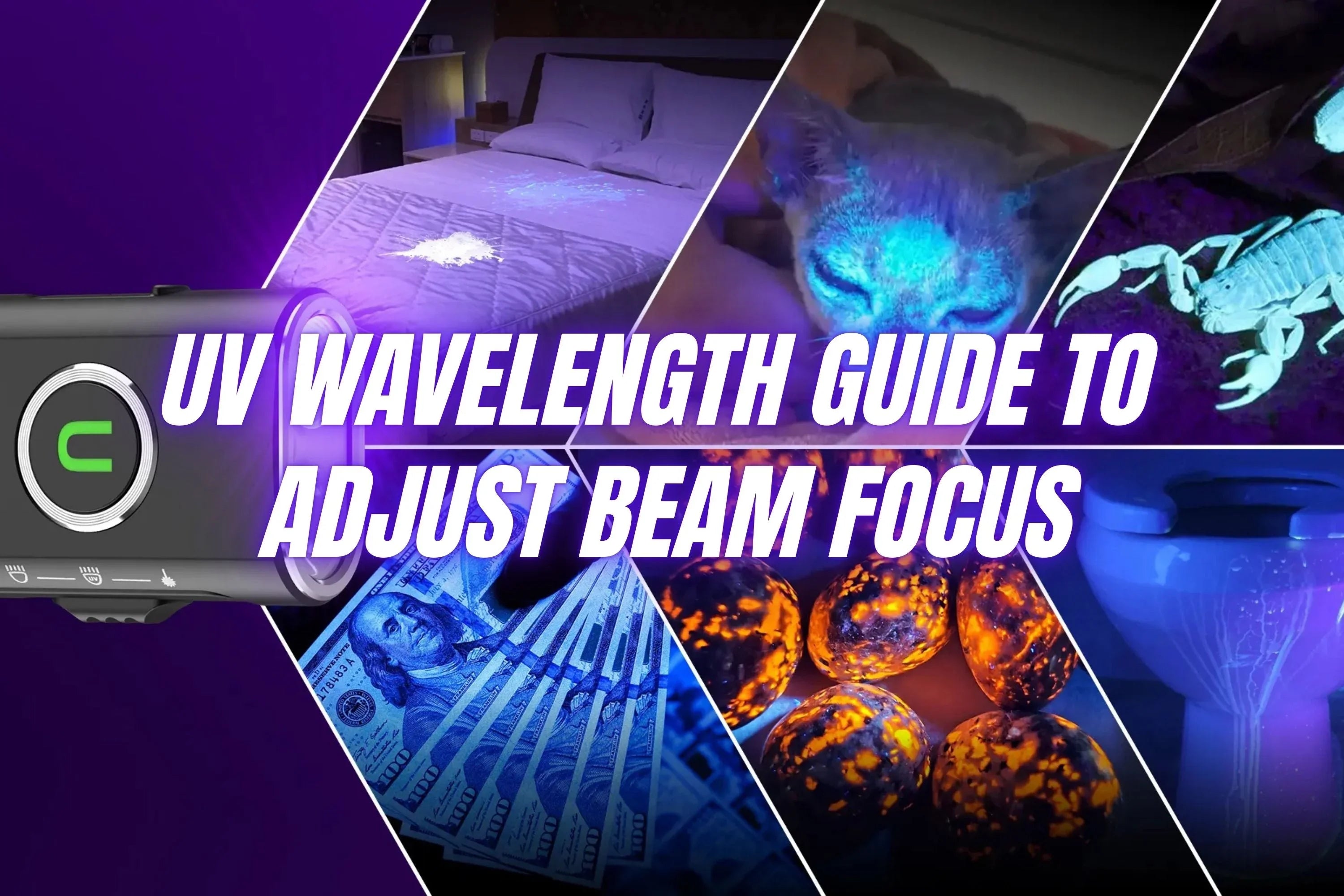High Brightness: Many tactical lights exceed 1,000 lumens for a long-reaching beam. For example, 1,000+ lumens is ideal for seeing far ahead on a trail. At the same time, most LEDs are energy-efficient, so a powerful light doesn’t drain batteries too quickly.
Multiple Modes: Typical modes include Low/Medium/High, plus Turbo/Burst (very bright for short times) and Strobe/SOS. Low mode saves power for close-up tasks, High mode lights up far distances, and Strobe/SOS signal emergencies. A well-designed user interface makes switching modes simple (usually one-button cycling or two-button control).
Rugged Durability: Most tactical flashlights have anodized aircraft-grade aluminum bodies to resist drops and corrosion. They often carry an IPX7 or IPX8 rating (waterproof up to 1 meter or more). This means the light can handle rain, splashes, and even temporary submersion without failing.
Intuitive Operation: A good tactical light is easy to use one-handed. Many have a tactical tail switch (clicky button on the back) so you can turn the light on/off and change modes with your thumb while holding it naturally. Side switches work too, placing controls under your thumb in a forward grip. Avoid overly complex multi-press sequences; fewer, well-spaced modes keep operation intuitive.
Emergency/Strobe Functions: Built-in Strobe and SOS modes provide critical safety functions. Strobe flashes the beam rapidly to attract attention or briefly disorient a threat, while SOS blinks an internationally recognized distress signal. Use Strobe only in true emergencies (e.g. to signal for help or startle an aggressive animal) since it also uses a lot of battery.
Beam Profile: Tactical flashlight beams have a bright hotspot at center and a dimmer surrounding spill. The hotspot (bright circle) reaches far ahead, while the spill lights up nearby areas. A throw (long-distance) flashlight uses a deep, smooth reflector to focus most light into its hotspot. A flood light uses a shallow, textured reflector to spread light widely for close-up tasks. This image shows a flashlight illuminating a forest path: notice the bright center and softer edges. Choosing throw vs. flood depends on your needs: hiking off-trail favors a long throw, while campsite chores or reading favor a wide flood beam.
Performance and Convenience
When choosing a tactical light, always weigh performance (brightness, range, battery life) against convenience (size, weight, ease-of-use). Here are the most important factors:
-
Lumen Output & Beam Distance: Look for the highest brightness you can afford and the beam distance you need. For camping or patrols, 500–2000 lumens provides ample brightness, whereas higher-end search tasks can use 3000+ lumens. (More lumens usually mean shorter runtime, so balance brightness with battery capacity.)
-
Battery Type & Runtime: Flashlights use various batteries. Rechargeable Li-ion cells (18650 or 21700 types) hold 2000–5000 mAh for long use and are rechargeable. Disposable CR123A (3 V) cells are smaller and high-drain but non-rechargeable. Alkaline AA/AAA batteries are cheap and available almost anywhere, but drain quickly in high-power lights. Consider what’s most convenient: a light with a built-in rechargeable cell (USB-C charging) or one that takes common batteries.
-
Size and Weight: A compact light is easy to carry, but very small lights may not hold big batteries or deliver extreme range. Choose a size that fits your hand and kit. Many tactical models balance compactness with power (for example, a 4–5 inch light that still throws hundreds of meters). A comfortable grip and a sturdy pocket clip or wrist strap also add convenience.
-
Durability: A light you carry outdoors should be tough. Check for waterproof ratings (IPX7/IPX8) so it won’t fail in rain or puddles. Drop resistance is also key—many tactical lights advertise drop tests (e.g. surviving a 1.5m drop). Hard anodizing or additional coatings protect against scratches.
By balancing these aspects, you ensure your flashlight performs when you need it while still being practical to carry and operate.
Key Features Explained
Below we explain common tactical flashlight features in plain language:
Brightness (Lumens)
Lumens measure how much light a flashlight puts out. In general, more lumens = brighter beam. Tactical flashlights often start around 500 lumens on Low, with 1000–2000 lumens on High. Some premium models exceed 3000 lumens. For reference, a standard desk lamp is about 400–800 lumens, so a 1000+ lumen torch is very bright. High output lights can light distant objects (hundreds of feet). However, higher brightness uses more battery: lights often have multiple levels (Low/Medium/High) so you can use only as much light as needed and save power.
Beam Pattern (Hotspot vs Spill)
A flashlight beam has a hotspot (bright center) and spill (dim glow around it). A throwy light has a narrow hotspot that shines far, good for seeing long distances (like an airplane landing). A floody light has a wide spill to light up a whole campsite nearby. The difference comes from the reflector shape: a deep, smooth reflector focuses light for maximum range, while a shallow, textured (orange-peel) reflector spreads light for a broad flood. Decide which you need: distance or wide coverage.
Lighting Modes
Most tactical lights offer several modes you cycle through with the switch. Typical modes: High (max brightness), Medium (balanced brightness/runtime), Low (for reading or conserving power), Turbo/Burst (extra-high brightness for short bursts), Strobe (rapid flashing), and SOS (blinks SOS in Morse code). For example: Turbo is ideal for spotting distant objects quickly; High for general outdoor use; Low for close-up work; Strobe/SOS for emergencies. Some lights remember the last mode when turned off. Keep it simple: a light with a few well-chosen modes is often easier to use than one with a dozen confusing settings.
Power and Battery Types
Choose a battery type based on convenience and performance. 18650 Li-ion batteries (common rechargeables) provide long runtime (often several hours on high) and high voltage (3.7 V nominal) for bright LEDs. A 21700 Li-ion cell is similar but larger capacity. CR123A cells are smaller, hold less charge, but can deliver high power; they are usually non-rechargeable (though rechargeable RCR123A exist). AA or AAA batteries (alkaline or NiMH) work in many lights; NiMH rechargeables are better under heavy use. Consider carrying spare batteries or a charger. Battery care: Always use the correct charger for Li-ion cells, and remove cells from the charger when full. Avoid mixing old and new or different types of batteries in the same light. If storing the light, remove batteries to prevent leaks.
Durability and Weatherproofing
Tactical flashlights are built to survive tough conditions. They often use anodized aluminum bodies to resist dents and corrosion. Knurled grip patterns help prevent slipping. Look for a rubber o-ring seal at the battery cap to keep water out. Most important is the IP (Ingress Protection) rating: for example, IPX4 means resistant to splashes, IPX7 means it can handle immersion up to 1 meter, and IPX8 means even deeper underwater. An IP68-rated light is dustproof and submersible. Even if you rarely go underwater, a waterproof light is more likely to survive rain or snow.
Controls and User Interface
A flashlight’s UI should be straightforward. Tail cap switches (on the butt end) are common and allow instant on/off with your thumb or finger while holding the light normally. For example, with a tail switch you can hold the light in an “overhand” or “cigar” grip and click with your thumb. Side switches let you use the light with a standard forward grip; the button near the head is easy to reach with your thumb. Some lights have both a tail and side switch for maximal flexibility. Avoid lights with very complex multi-click modes unless you really need them; in most situations fewer modes with a simple tap or press combination is better. It’s also handy if the light can tail-stand (stand upright on its base) for hands-free area lighting.
Flashlight Components: A tactical flashlight typically has a sturdy metal body, a pocket clip or lanyard (as shown here), and a bezel around the lens (often crenelated). The tail cap houses the on/off switch and often a retention ring or magnet. Inside are the battery tube, battery contact springs, and circuit board that connects the battery to the LED. The head contains the LED emitter and reflector/lens assembly. All these parts should fit tightly and cleanly: dirt on the threads can damage seals. To operate it, hold the light firmly (grip example shown) and use your thumb or finger to press the switch.
Usage Scenarios
Tactical flashlights shine in many situations. Here’s how their features come into play:
-
Camping/Hiking: A good camping flashlight is bright but portable. Use High mode when hiking on unlit trails; switch to Low for reading a map. A tail-stand or removable diffuser (if available) lets the light illuminate a tent or campsite hands-free. Bring spare batteries or a model with USB recharge for multi-day trips. In an emergency (lost or injured), switch to SOS mode or use strobe to signal for help. The waterproof and impact-resistant design means the light won’t fail if dropped in puddles or on rocks.
-
Security Patrols: Guards on patrol need quick access and reliability. A compact yet powerful light (e.g. 500–1000 lumens) lets you scan dark hallways or parking lots. The light should turn on immediately with one click (no delay). A steady High beam can expose hidden corners, while a brief strobe might deter a suspicious person. Since patrols may extend outdoors in any weather, a rainproof IPX rating and shockproof body ensure your light keeps working. The cigar grip (forward) or overhand grip with thumb switch allows silent operation without fumbling a flashlight keychain.
-
Law Enforcement/Inspection: Police and inspectors use tactical lights for search and examine tasks. A very long-throw flashlight (deep reflector, 1000+ lumens) can light up distant objects and far-off suspects. During vehicle or building searches, the compact light from this pathfinder can enter under trucks or crawl spaces. The Strobe mode is used sparingly (to disorient a threat if necessary), and SOS for backup calls. A strong bezel (often metal) can break a window in an emergency. The wrist strap or clip keeps the light handy at all times. After an inspection, wipe the light’s lens and body clean from dust or contaminants.
-
Emergency Use: In power outages, car breakdowns, or natural disasters, a flashlight is essential. Prefer longer runtime models (bigger batteries or rechargeables) so the light stays on for hours. Use the Low or Medium mode for general illumination (to make power last), and High only briefly for tasks like finding a fuse box or assessing storm damage. Keep an Emergency Strobe/SOS mode for calling for help if needed. A weatherproof design means the light still works in rain or cold. In cold weather, be aware that alkaline batteries lose efficiency, so a lithium or rechargeable battery is better.
 When hiking or camping at night, a tactical flashlight provides a bright and focused beam that cuts through darkness. In this photo a person lights a forest path; the strong LED creates a clear hotspot while scattering some spill light around. Use the beam controls wisely: a long-throw beam (from a deep reflector) will reach distant trail markers, whereas a wider beam helps with close-up tasks like reading a compass or pitching a tent. Always carry spare batteries and operate at lower modes to stretch your light’s runtime over the whole trip.
When hiking or camping at night, a tactical flashlight provides a bright and focused beam that cuts through darkness. In this photo a person lights a forest path; the strong LED creates a clear hotspot while scattering some spill light around. Use the beam controls wisely: a long-throw beam (from a deep reflector) will reach distant trail markers, whereas a wider beam helps with close-up tasks like reading a compass or pitching a tent. Always carry spare batteries and operate at lower modes to stretch your light’s runtime over the whole trip.
 Security and patrol personnel often need to inspect vehicles, undercarriages, or dark alcoves. Here, a mechanic uses a handheld light to examine a car suspension; similarly, officers use flashlights to check under cars for contraband or to read VINs. A tactical light lets them aim the beam precisely while both hands stay free for tools. For such inspection work, a compact, penlight-sized tactical flashlight (or handheld work light) with a 360° swivel hook can also be useful. Ensure the light remains steady (many models have a bright, flood-style low mode for broad area lighting).
Security and patrol personnel often need to inspect vehicles, undercarriages, or dark alcoves. Here, a mechanic uses a handheld light to examine a car suspension; similarly, officers use flashlights to check under cars for contraband or to read VINs. A tactical light lets them aim the beam precisely while both hands stay free for tools. For such inspection work, a compact, penlight-sized tactical flashlight (or handheld work light) with a 360° swivel hook can also be useful. Ensure the light remains steady (many models have a bright, flood-style low mode for broad area lighting).
Operation and Maintenance
Holding and Operating the Flashlight
Hold the flashlight firmly with your dominant hand. For a cigar grip, point the lens forward and wrap your fingers around the body; your thumb naturally rests on the tail switch. This allows quick on/off without changing your hold. Alternatively, grip it like a baseball bat (lens downward, tail up) if that’s more comfortable – just ensure you can still reach the switch. In tight spaces, a reverse (underhand) grip may be used, but the overhand thumb grip is fastest for toggling modes. The image above shows a common holding position. If the flashlight has a clip, you can attach it to a belt, hat brim, or pocket for hands-free use. Tail-stand the light (set it on its butt end) when you need a small area light on a flat surface.
Battery and Charging Tips
-
Use Quality Cells and Chargers: Always use the right charger for your flashlight’s battery type. Many tactical lights come with USB-C charging ports for their built-in Li-ion cells. Unplug the charger when the battery is full (overcharging can shorten battery life). A charger with “CC/CV” (constant current/constant voltage) is safest for Li-ion.
-
Avoid Mismatched Batteries: Never mix old and new batteries, or different brands/types in the same light. This can cause uneven discharge or even heat. If your light uses two or more cells in series, make sure they are at the same charge level (never put a fresh cell in with a nearly dead one).
-
Monitor Temperature: Batteries and flashlights can get hot under heavy use or charging. If the light or charger becomes very hot, stop charging or let the light cool down before using. Don’t leave charging batteries unattended for long periods.
-
Storage: For short-term storage, remove the batteries from the flashlight to prevent drain and possible corrosion. For long-term storage of Li-ion cells, it’s best to store them at about 50% charge in a cool, dry place. (Do not freeze batteries, keep them above 0°C.)
-
Spare Power: In remote or duty situations, always carry extra batteries or a backup flashlight. Even a high-capacity 21700 cell will eventually run out on high mode.
Cleaning and Care
-
Lens Cleaning: Keep the lens clean for maximum brightness. Use a soft microfiber cloth (like an eyeglass cloth) to wipe off dust and fingerprints. For smudges, apply a small amount of mild glass cleaner or isopropyl alcohol to the cloth (never spray liquid directly on the lens). Wipe in a gentle circular motion. Avoid rough cloths or paper towels that can scratch the lens coating.
-
Exterior Maintenance: Wipe the body with a damp cloth to remove dirt. Check and clean the threads of the tail cap – debris can damage the sealing o-ring. If needed, re-lubricate the o-ring lightly with silicone grease to maintain water resistance. Make sure the o-ring is intact and properly seated after any cleaning.
-
General Care: If your flashlight gets wet (rain, snow, or a dunk in water), dry it thoroughly before opening the battery compartment. Remove batteries and dry inside if water got in. Avoid dropping the light on hard surfaces; although tactical lights are tough, repeated heavy impacts can loosen components.
FAQ
Q: What’s the difference between beam “throw” and “flood” (spill)?
A: Beam throw refers to how far the flashlight’s hotspot reaches. A deep, smooth reflector focuses the light for long distance (high throw). Flood (spill) means how wide the beam is spread. A shallow, textured reflector spreads light broadly for near-field illumination. In practice, a “thrower” flashlight will light up distant objects, while a “floody” one will more evenly light the area right in front of you.
Q: How should I care for the flashlight’s battery?
A: Use the recommended charger and follow basic Li-ion safety. Charge only in a safe place and unplug when done. Do not charge a drained alkaline or old battery inside the light. Always match battery types (never mix old/new or different chemistries). If using two cells in series, ensure they have equal charge before installing. Store cells partly charged (around 50%) for long periods, and remove batteries if storing the flashlight unused.
Q: What do IPX or IP ratings mean for flashlights?
A: IP ratings describe water/dust protection. The first digit (often “X” if not rated for dust) and second digit indicate levels. For example, IPX4 means splash-resistant, IPX7 means the light can survive being submerged up to 1 meter for 30 min, and IPX8 means even deeper immersion. An IP68 rating (as found on many tactical lights) means it is fully dustproof and waterproof up to 1–2 meters. In everyday terms, look for at least IPX4 for rain, and IPX7/8 if you need to use the light in heavy rain or shallow water.
Q: What’s the best way to hold a tactical flashlight?
A: Use a firm grip. A cigar grip (holding the light out in front like a torch) with your thumb on the switch is common. This lets you turn it on/off quickly without changing your hold. You can also grip it in your palm with the tail end in your hand and push the switch with your finger. The key is that your thumb (for tail switch) or finger (for side switch) can reach the button easily. Always point the light where you want it, and keep a second hand free if you need to open doors or hold equipment. A wrist strap or pocket clip adds safety, so you don’t drop the light.
Q: How do I clean my flashlight and lens safely?
A: Gently clean the lens with a soft microfiber or lens cloth to remove dirt and fingerprints. If needed, moisten the cloth with a drop of eyeglass cleaner or isopropyl alcohol (apply liquid to the cloth, not directly on the lens). Wipe in circular motions and avoid pressing too hard. For the body, simply wipe with a damp cloth; use a brush or toothpick to clear grit from the tail cap threads. Always re-seat the o-ring properly after cleaning to maintain waterproofing.
Q: When should I use the strobe or SOS mode?
A: Strobe is an emergency mode. It rapidly flashes the beam, which can disorient a threat or draw attention. Law enforcement or security might use a strobe briefly in a dangerous encounter. For everyday or camping use, strobe is mainly useful for signaling (it’s very attention-grabbing). The SOS mode automatically blinks “SOS” in Morse code to signal for help if you’re lost or hurt. In non-emergencies, avoid strobe to conserve battery and avoid unnerving bystanders.
Q: What does “lumens” mean and how many do I need?
A: Lumens measure total light output. More lumens means a brighter light. For general tasks, 100–500 lumens can be adequate (like a strong household flashlight). For tactical or outdoor use at night, 1000+ lumens is common and allows long-distance illumination. LEDs today can range from a few dozen lumens up to tens of thousands. Choose a light with a maximum lumen level that meets your needs, keeping in mind that higher lumens will drain batteries faster. A model with multiple levels lets you use high power when needed and lower levels to extend runtime.
Q: How do I care for the flashlight physically?
A: Treat it like any precision gear. Don’t drop it repeatedly on concrete (anodized aluminum is tough but not indestructible). After heavy use or rain exposure, wipe it dry. Periodically inspect the o-ring seals (replace if cracked) and threads (re-grease with silicone grease if they feel dry). Keep the tail cap and switch clean of dirt. Finally, don’t store the light with the switch turned on (even if in a pocket, bumping the switch can drain the battery or damage the light).
Q: What batteries should I carry or buy for tactical flashlights?
A: If your light takes 18650/21700 cells, carry quality protected Li-ion batteries (these have built-in safety circuits). A typical high-quality 18650 might be 2500–3500 mAh. Always use the same type and brand together. If your light uses CR123A, carry fresh spares; note that two CR123A give about 6 V, similar to one 18650. AA flashlights should use NiMH rechargeables for best performance. Lithium (non-rechargeable) AA cells work well in cold temps. In any case, avoid mixing used and new cells.
This manual is meant to guide both first-time buyers and seasoned professionals to get the most out of a handheld tactical flashlight. By focusing on convenience (easy operation, lightweight, battery care) and performance (brightness, range, durability) you’ll choose and use a flashlight that serves you well in camping, patrol, and emergency duty. Always read the specific instructions for your flashlight model, and practice using its modes before you need it in the dark. Stay safe and be prepared!

